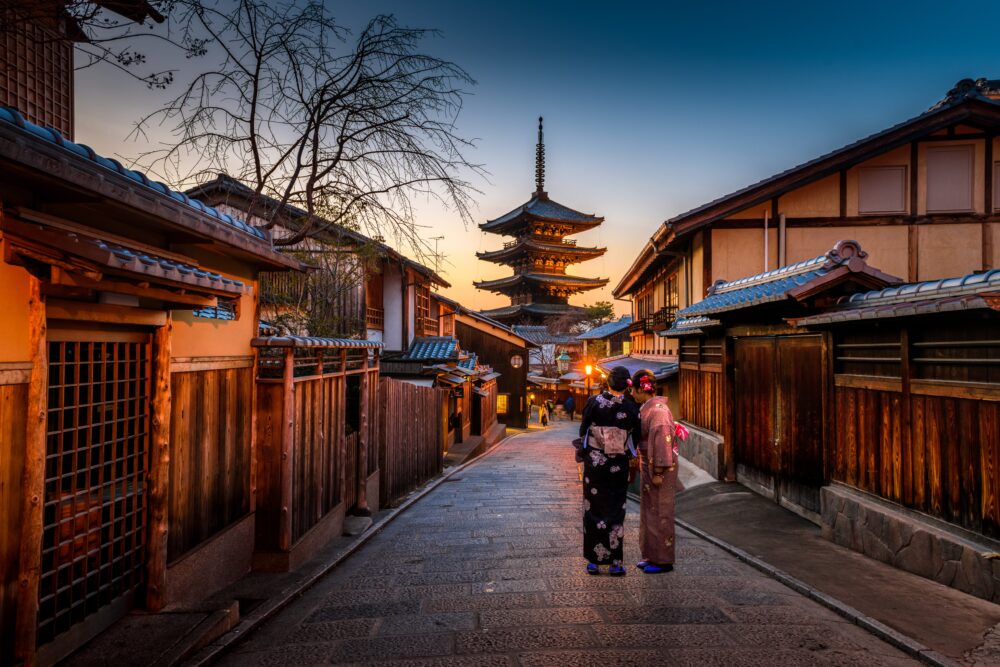
Hello, this is Positive Research Institute @Kuma-san!
Today, I want to share with you the charm of Japan, a country that attracts attention from all over the world.
By reading this article, you will surely be captivated by Japanese culture, landscapes, and its heartwarming hospitality.
Let’s explore the wonderful aspects of Japan together!
The Fusion of Tradition and Innovation – Japanese Culture
Japanese culture is characterized by the beautiful fusion of tradition and innovation. In this country, where long-standing traditional culture coexists with cutting-edge technology and pop culture, you can experience a journey through time in just one day.
For example, in ancient capitals like Kyoto and Nara, you can visit shrines and temples with hundreds of years of history. In these places, you can stroll through tranquil gardens or experience the elegant tea ceremony. On the other hand, in urban areas like Tokyo and Osaka, you can immerse yourself in bustling streets illuminated by neon lights and experience the latest in anime and fashion.
Furthermore, traditional Japanese performing arts are not to be missed. Noh and Kabuki are unique forms of Japanese theater, possessing a distinctive aesthetic and deep narrative quality. These traditional arts are essential for deeply understanding Japanese culture and history.
Additionally, traditional Japanese crafts are also noteworthy. For example, Kanazawa’s gold leaf, Kyoto’s Nishijin weaving, and Aomori’s Tsugaru lacquerware, rooted in various regions, reflect the history and culture of those areas. These crafts demonstrate the delicate aesthetic sense and high level of craftsmanship in Japan.
Meanwhile, Japan is also a world leader in the field of science and technology. For instance, in the fields of robotics, the automotive industry, and electronic devices, Japan’s innovation shines. Japanese anime and video games are loved worldwide and have established themselves as unique aspects of Japanese pop culture.
Thus, Japanese culture has developed through a harmonious blend of old and new, influencing each other. When you visit Japan, be sure to feel the depth and diversity of this rich culture.
The Beauty of Nature – The Four Seasons
Japanese nature is rich in seasonal changes, with each season having its unique beauty. In Japan, you can enjoy different landscapes in spring, summer, autumn, and winter.
Spring is especially beautiful in Japanese nature. During this season, when cherry blossoms bloom, Japan is dyed in pink. There are many famous cherry blossom spots nationwide, such as parks, riverbanks, and around ancient castles. The cherry blossom viewing (hanami) event is a symbol of Japanese spring. Also, the fresh greenery of spring is beautiful, with mountains and parks wrapped in vivid green.
In summer, Japanese nature gains more vitality. You can enjoy unique summer landscapes, such as the vast lavender fields in Hokkaido and the beautiful beaches in Okinawa. Also, many regions in Japan hold festivals during summer, featuring traditional dances and fireworks. These festivals are enjoyable events that make you forget the summer heat.
Autumn is the season when Japanese nature becomes most colorful. The autumn leaves color the mountains in red, yellow, and orange, creating beautiful scenery. Places like Kyoto and Nara’s ancient temples, Nikko, and Hakone in the mountainous areas are known for their autumn leaves. Autumn is also a season rich in seasonal foods, such as new rice, sweet potatoes, and chestnuts.
Winter is the season when Japanese nature regains its tranquility. In areas like Hokkaido and Tohoku, snow accumulates deeply, allowing you to enjoy winter sports and hot springs. Famous examples include ski resorts in Nagano and the Snow Festival in Hokkaido. Also, winter illuminations are beautiful, and you can enjoy festivals of light in urban areas.
In this way, Japanese nature shows different faces in each season, offering diverse attractions suited to each season. When you visit Japan, be sure to experience the beauty of nature in each season.
The Spirit of Hospitality – Unique Japanese Services
The spirit of “Omotenashi,” or Japanese hospitality, is highly regarded worldwide for its unique service spirit and meticulous attention to detail. This culture of hospitality is rooted in traditional Japanese values, providing unforgettable experiences to visitors.
Japanese hospitality starts with accommodation facilities. In traditional inns (ryokan), room attendants take care of guests individually, providing detailed services from meal preparation to laying out futons. In hotels, staff flexibly respond to guests’ needs, supporting a comfortable stay.
In dining establishments, the spirit of Japanese hospitality is also evident. Staff members strive to create an environment for guests to enjoy their meals, commonly explaining dishes in detail, including the origins of ingredients. They also offer menus considering guests’ preferences and allergies.
In public spaces, the spirit of Japanese hospitality can also be felt. For example, at train stations, signs are often displayed in multiple languages, considerate of foreign travelers. Taxi drivers provide detailed services, such as automatic door opening and luggage handling.
In this way, the spirit of Japanese hospitality provides comfort and peace of mind to visitors, offering deep experiences of Japanese culture. When you visit Japan, be sure to experience this unique service spirit.
A Culinary Nation – Japanese Food Culture
Japan is known for its diverse and delicate food culture. Japanese food culture is characterized by regional specialties and dishes using seasonal ingredients. Traveling around Japan, you can experience the unique flavors and traditions of each region.
Sushi, a representative of Japanese cuisine, is a simple yet sophisticated dish using fresh seafood. Originating in Tokyo (formerly Edo) during the Edo period, sushi is now loved worldwide. At sushi restaurants across Japan, you can enjoy unique sushi using local seafood.
Japanese ramen is also very popular. Ramen comes in various soup and noodle combinations, such as soy sauce, miso, salt, and pork bone, each with its regional characteristics. For example, miso ramen in Sapporo, Hokkaido, and pork bone ramen in Hakata, Kyushu, are famous.
Tempura is another representative Japanese dish. Fresh seafood and mountain produce are coated in a crispy batter and served hot. Tempura, which became popular among the common people during the Edo period, is still loved by many today.
Local Japanese dishes are also not to be missed. For example, Okinawa’s Goya Champuru and Hokkaido’s Jingisukan are unique to each region. These dishes reflect the local climate and culture, offering new taste discoveries to visitors.
Additionally, traditional Japanese cuisine (washoku) values the sense of season. Dishes using seasonal ingredients offer flavors unique to each season. Washoku is also known for its cooking methods that bring out the taste of the ingredients and its beautiful presentation.
In this way, Japanese food culture consists of a variety of dishes reflecting regional characteristics and seasonal changes. When you visit Japan, be sure to enjoy these culinary delights.
Technological Evolution – Japanese Innovation
Japan is one of the world leaders in technological innovation. Japanese technology is used in various aspects of daily life, and its evolution is remarkable.
Japan’s automotive industry is known for its high technical capabilities and innovation. Car manufacturers like Toyota, Honda, and Nissan focus on developing environmentally friendly hybrid and electric vehicles. These cars are highly rated worldwide for their fuel efficiency, quiet operation, and low emissions.
Japan’s electronics industry is also globally renowned. Companies like Sony, Panasonic, and Sharp provide high-quality and innovative products such as televisions, cameras, and audio equipment. These products, known for their excellent design and performance, are used and loved worldwide.
Japanese robotics technology is also a notable field. Japanese robots are active in various areas, from industrial to caregiving robots. In particular, the development of humanoid robots that mimic human movements has attracted global attention.
Furthermore, Japan is a leader in railway technology. The Shinkansen, known for its high speed and punctual schedule, is a safe and comfortable travel option for many people. Also, in earthquake-prone Japan, building technology is highly valued, and the construction of earthquake-resistant buildings is advanced worldwide.
In this way, Japanese technological innovation enriches daily life and expands possibilities for the future. When you visit Japan, be sure to experience these cutting-edge technologies.
Conclusion
Japan, with its rich culture, beautiful nature, heartwarming hospitality, exquisite food culture, and innovative technology, is a country loved worldwide. Through this article, we introduced the diverse charms of Japan, but by actually visiting and experiencing them, you can truly feel their beauty.
Japanese culture offers a constant surprise to visitors with its fusion of old traditions and the latest innovations. The beauty of nature is rich in seasonal changes, allowing you to enjoy different landscapes in each season. The Japanese spirit of hospitality provides comfort and peace with meticulous attention and warm service.
In terms of food culture, you can enjoy traditional regional dishes and exquisite cuisine made with fresh ingredients. In terms of technology, Japan leads the world with innovative technologies that enrich everyday life with various products and services.
Visiting Japan is not just a trip, but a unique adventure where you can experience culture, nature, food, and technology. We hope this article serves as a starting point for you to feel the charm of Japan. And if you have the opportunity to visit Japan, be sure to experience these charms firsthand.
Press on with determination! Never look down, always look forward, and keep moving forward!

